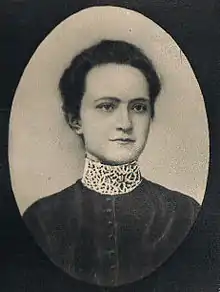Wanda Krahelska-Filipowicz
Wanda Krahelska-Filipowicz (15 December 1886–1968),[1] code name “Alinka””[2] or “Alicja”, was a leading figure in Warsaw’s underground resistance movement[3] throughout the years of German occupation during World War II in Poland, co-founder of Żegota.[4] As the well-connected wife of a former ambassador to Washington, she used her contacts with both the military and political leadership of the Polish Underground to materially influence the underground's policy of aiding Poland's Jewish population during the war.

Early on, Krahelska-Filipowicz used her influence to persuade the Government in Exile, including members of the Delegatura and its military counterpart, the AK, of the importance of setting up a central organization to help Poland's Jews, and to back the policy with significant funding.[5]
Krahelska-Filipowicz also personally sheltered Jews in her own home early during the German occupation,[6] regardless of the punishment announced by the Nazi German occupants of Poland for any Pole doing this, which was death. Among the refugees was the widow of the Jewish historian Szymon Aszkenazy.[7]
A Catholic Socialist activist and a devout Democrat, she was the editor of the Polish art magazine "Arkady".
In the pre-World War I partitioned Poland, on 18 August 1906, at the age of twenty she took part in an assassination attempt on the Russian governor-general of Warsaw, Georgi Skalon.[8] She threw three 'dynamite bombs' on the governor's coach; two did explode and slightly injured three persons in governor's entourage. Afterwards, she fled to Cracow in Austrian part of Poland, entered into fictional marriage with painter Adam Dobrodzicki and became citizen of Austria-Hungary. Austria refused to extradite her to Russia and instead arranged a trial in Wadowice, starting on 16 February 1908. Wanda Dobrodzicka had confessed but was acquitted.
References
- "The story of Wanda Krahelska-Filipowiczowa | Polscy Sprawiedliwi". sprawiedliwi.org.pl. Retrieved 2019-01-10.
- Bartrop, Paul R.; Dickerman, Michael (2017-09-15). The Holocaust: An Encyclopedia and Document Collection [4 volumes]. ABC-CLIO. ISBN 9781440840845.
- Atwood, Kathryn J. (2011). Women Heroes of World War II: 26 Stories of Espionage, Sabotage, Resistance, and Rescue. Chicago Review Press. ISBN 9781556529610.
- Tomaszewski, Irene; Werbowski, Tecia (2010). Code Name Żegota: Rescuing Jews in Occupied Poland, 1942-1945 : the Most Dangerous Conspiracy in Wartime Europe. ABC-CLIO. ISBN 9780313383915.
- Ackerman, Diane (2017-02-07). The Zookeeper's Wife: A War Story (Movie Tie-in) (Movie Tie-in Editions). W. W. Norton & Company. ISBN 9780393354263.
- zbiorowy, autor (2015-11-23). Wielka Księga Armii Krajowej (in Polish). Otwarte. ISBN 9788324034314.
- Lewinówna, Zofia (1969). Righteous among nations: how Poles helped the Jews, 1939-1945. Earlscourt Publications Ltd. ISBN 9780901780010.
- Instytut Historii (Polska Akademia Nauk) (1971). Raporty warszawskich oberpolicmajstrów, 1892-1913. Ossolineum. p. 75. Retrieved 4 May 2012.